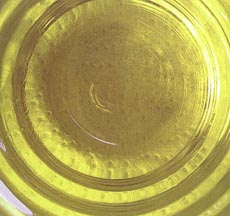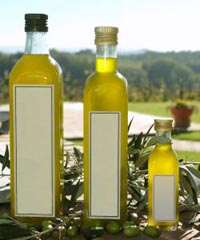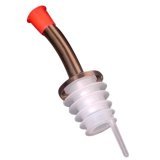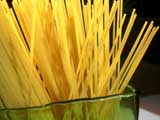

Olive oil from the Greek island of Lesvos. For more information on olive oil from Lesvos, visit E-Lesvos.net.
|
| KAREN HOCHMAN is Editorial Director of THE NIBBLE™. |
|
November 2005
Updated May 2007
|
 |
Tasting Olive Oil
How To Taste & Evaluate Olive Oil
Overview
Olive oil is judged like wine, by its organoleptic, or sensory, properties: color, bouquet, and taste. These qualities depend on the ripeness of the olives when harvested, how they were kept after picking and how the oil was extracted.
- Color is tinged green by the chlorophyll of green olives or yellow by mature olives. The amount of carotene determines how yellow the oil may become. As the oil becomes old and oxidized, a red tint will emerge.
- Bouquet is determined by the volatile compounds in the oil: alcohols, aldehydes, esters, and hydrocarbons, ketones. Oil processed at high temperatures, improperly stored, chemically extracted or exposed to light will lose these ephemeral compounds and the bouquet will dissipate.
- Taste involves the bouquet in combination with the four “gustatory senses”: salty, acidic (tart), bitter and sweet.
For the purposes of trade classification, the International Olive Oil Council’s accredited tasting panels use a limited number of descriptors: their goal is to screen out oils that have been improperly produced. For the enjoyable and educational pursuit of tasting and evaluating different olive oils, dozens of different descriptors can be used. Think of it like tasting and comparing wines.
 Unlike with many wines, however, olive oil does not improve with age: it will never be better than it is in the year of its production. Plus, the appearance of the olive oil is not an evaluation factor—in fact, blue glasses, not clear ones, are used at official olive oil tastings so that the color doesn’t influence the judges. While consumers have been led to believe that intensity of color equates to intensity of flavor, and a dark green color denotes quality, there is no hard and fast rule. Numerous factors contribute to color, including the variety of olive, terroir, and processing. Unlike with many wines, however, olive oil does not improve with age: it will never be better than it is in the year of its production. Plus, the appearance of the olive oil is not an evaluation factor—in fact, blue glasses, not clear ones, are used at official olive oil tastings so that the color doesn’t influence the judges. While consumers have been led to believe that intensity of color equates to intensity of flavor, and a dark green color denotes quality, there is no hard and fast rule. Numerous factors contribute to color, including the variety of olive, terroir, and processing.
Conducting A Tasting
Here’s how the professionals taste oil: you can adapt your technique accordingly. This process works for any type of food or beverage tasting.
Planning For The Tasting
- Tastings are held in the morning, ideally one hour after a light meal, when the taste buds are the freshest. Don’t worry if you do yours in late afternoon, pre-cocktails, or in the evening: the financial future of a company or a village will not depend on the outcome. You just don’t want to be either hungry or full.
- Tasters do not wear cologne or use scented cosmetics, talcs, soaps or hair products; and are careful not to be in contact with any environmental scents that they could bring to the tasting in their clothes and hair (sachets, smoke, mothballs).
- There is no smoking, teeth-brushing, use of mouthwash, mints, gum, or anything else that could affect the taste buds prior to the tasting (like drinking an espresso) for at least 30 minutes prior to the tasting.
Arrangements
- Set-up. You can set up a tasting bar on a table, bar or sideboard and have a casual tasting where guests mingle and go to back and forth to the tasting bar at will. Or, you can conduct a formal seated event around a table where everyone tastes in unison.
- Serving. You can pre-pour the servings into cups, hire an “oil sommelier” to pour if it’s a big event or recruit a volunteer from the group if it’s a small one, or let
 guests pour their own (at the table this is done by passing the bottle). Buy inexpensive pouring spouts or your table may drink more oil than your guests. Tiny plastic medicine cups—available at medical supply stores or click here—are often used. For more elegance, shot glasses or liqueur glasses can be rented from a party supply service. You can also purchase attractive plastic shot glasses in quantity, which will see you through a few tastings. guests pour their own (at the table this is done by passing the bottle). Buy inexpensive pouring spouts or your table may drink more oil than your guests. Tiny plastic medicine cups—available at medical supply stores or click here—are often used. For more elegance, shot glasses or liqueur glasses can be rented from a party supply service. You can also purchase attractive plastic shot glasses in quantity, which will see you through a few tastings.
- Tasting. While professionals judge from a very generous portion, a consumer tasting should dispense half ounce portions, or half a shot glass. A more environmentally-friendly technique used at trade tastings—although non-
 professionals may find it unalluring—is to dip a strand of dry spaghetti into the oils and taste the oil from the end of the spaghetti stick. Another ecological and cost-effective option is to give people a soup spoon or tablespoon and let them pour from the bottle, over a plate. This works whether you are standing at a tasting table, or seated and passing the bottle around. It does, however, require that your guests be fairly coordinated. professionals may find it unalluring—is to dip a strand of dry spaghetti into the oils and taste the oil from the end of the spaghetti stick. Another ecological and cost-effective option is to give people a soup spoon or tablespoon and let them pour from the bottle, over a plate. This works whether you are standing at a tasting table, or seated and passing the bottle around. It does, however, require that your guests be fairly coordinated.
- How Many Oils To Taste. This is the controversial paragraph of this article. Professionals advise never to taste more than four oils at a time, especially freshly pressed oils, because the peppery element can become cumulative and cloud accurate judgment. We have tasted a dozen oils at a time with absolutely no palate fatigue; but then, we regularly taste a dozen or more wines, chocolates, and other demanding foods at a time, as do many connoisseurs. We also are not likely to choose an entire crop of oils that is fresh-pressed and overly peppery: we’d go for variety. That’s another important point: professional tasting panels are focusing on oils from a specific area, while you can choose oils from different locales with diverse characteristics. There’s also energy from the size and social nature of your group: a group of consumers interacting amicably and exchanging thoughts without the burden of professional duties can taste a dozen oils more enjoyably than a few focused professionals can. So our recommendation is: if you have a sophisticated and enthusiastic group of tasters, go for the greater diversity and put together a tasting of a dozen oils. The first purpose of the tasting is to learn; and since you’re investing your time and money, learn as much as you can.
 Tasting Notes. Provide a tasting grid for notes and a writing instrument per person. Depending on the number of oils you are tasting, the grid can be as simple as a table on a horizontally-laid out page (select Landscape Mode under Page Set-Up in your word processing program) with two columns. The left column specifies the oils (Oil #1, Oil #2, etc.) if you want to taste the oils blind and reveal what they are at the end of the tasting.* The right column is a larger space for notes. After all oils have been tasted and commented upon, ask people to select their first, second and third choices. Then give each person a sheet revealing the identities and all product details: name, producer, country and region, olive varietal, price, etc., and where they can be purchased. This should engender more conversation about regional flavors, varietal flavors, price/value, et al. Tasting Notes. Provide a tasting grid for notes and a writing instrument per person. Depending on the number of oils you are tasting, the grid can be as simple as a table on a horizontally-laid out page (select Landscape Mode under Page Set-Up in your word processing program) with two columns. The left column specifies the oils (Oil #1, Oil #2, etc.) if you want to taste the oils blind and reveal what they are at the end of the tasting.* The right column is a larger space for notes. After all oils have been tasted and commented upon, ask people to select their first, second and third choices. Then give each person a sheet revealing the identities and all product details: name, producer, country and region, olive varietal, price, etc., and where they can be purchased. This should engender more conversation about regional flavors, varietal flavors, price/value, et al.
*To mask the bottles for a blind taste, put them in silver wine gift bags, use brown paper bags from a wine store, or simply cover them in aluminum foil.
- Other Needs. In addition to tasting cups or spoons, provide a spitting glass—ideally an opaque glass, or even a mug—for tasters who don’t want to swallow their oil. Also provide water glasses and pitchers of ice water for thirsty tasters, apples for palate cleansing (if a sit-down, providing individual plates and knife and decorating the table with baskets of apples is festive). Include sliced baguette for those who want some as a palate cleanser—or who just need need to “mop up the oil.” And of course, in addition to napkins, have paper towels at the ready for spills.
- After the tasting, you may wish to serve a light lunch or dinner: pasta salad, crudités, wrap sandwiches, iced tea and wine, with fruit, cheese and biscotti for dessert.
Party Checklist
| Set-Up |
Foods |
Beverages |
- Tasting cups, glasses or
spoons
- Pouring spouts for oil
bottles
- Napkins
- Placemat for olive oil cups
- Side dish for apples and
bread
- Knives (for apples)
- Water glasses
- Spitting glasses
- Plates
- Note paper, pens/pencils
|
- Olive oils
- Apples
- Baguettes
- Post-tasting menu
foods
|
- Ice Water
- Post-tasting
menu beverages
|
Tasting Process
- Color. Professionals don’t evaluate color. In fact, a blue or green colored glass is used to mask the color of the oil, so that it does not prejudice the taster. However, consumers don’t need to worry about clear cups versus blue glass like the professionals use—for us it’s a learning experience, not a professional evaluation. We need to see how the colors vary. Take notes on the color as part of the sensory (a.k.a. organoleptic) experience—and see for yourself if there’s any correlation between color and quality.
- Temperature. In a professional tasting, the oils are warmed to 82° to 86°F. Heat brings out the aromas and qualities of oil; cold suppresses them. Room temperature is satisfactory for a consumer tasting. If your oils have been sitting in a cold garage, cellar or car, bring them into the kitchen or warm tasting room at least two hours before the tasting. To apply the “professional touch” when tasting, you can breathe over the top of of your glass or cup to warm it slightly.
- Aroma. Professional evaluators will inhale a 5-ounce (15 ml) glass of olive oil—that’s the equivalent of a generous glass of wine—covering the top with their hands to seal in the vapors as they swirling the oil around. They’ll inhale the aromas for about 15 seconds to get a first impression and will continue to inhale to confirm, expand or negate the first impression. It’s very much like a wine tasting. For a consumer, a one-ounce (one tablespoon) individual tasting cup is perfect; providing everyone with five ounces is unaffordable and/or wasteful.
If you are having a tasting with friends, pour one five-ounce wine glass and take turns inhaling. Take notes on the aromas (see the chart here.)
Note: Some people aren’t comfortable with drinking oil straight, and prefer to use slices of baguette or boiled potato. The flavor of the food gets in the way and the bread fills you up; but if you must use it, find a truly bland, flavorless bread and cut it into very thin slices. Use the bread more to sop up the oil, so you are consuming as much oil by volume as bread.
- Taste. Take a sip of the oil. Swirl it around in your mouth so it touches all surfaces, and note the initial and middle palate flavors. Swallow it and note the after-palate sensation. If you are tasting a dozen oils and don’t want to the calories of 12 ounces of olive oil (remember, it has great health benefits), you can spit it out as wine tasters do.
- Palate-Cleansing. To cleanse the palate between tastings, eat a piece of apple, not bread. The acidity in the apple helps clear the palate of the oil. Drinking water doesn’t help: oil and water don’t mix.
Click here to continue to Part II: The Flavors & Aromas Of Olive Oil
Lifestyle Direct, Inc. All rights reserved. Images are the copyright of their individual owners.

|





 Unlike with many wines, however, olive oil does not improve with age: it will never be better than it is in the year of its production. Plus, the appearance of the olive oil is not an evaluation factor—in fact, blue glasses, not clear ones, are used at official olive oil tastings so that the color doesn’t influence the judges. While consumers have been led to believe that intensity of color equates to intensity of flavor, and a dark green color denotes quality, there is no hard and fast rule. Numerous factors contribute to color, including the variety of olive, terroir, and processing.
Unlike with many wines, however, olive oil does not improve with age: it will never be better than it is in the year of its production. Plus, the appearance of the olive oil is not an evaluation factor—in fact, blue glasses, not clear ones, are used at official olive oil tastings so that the color doesn’t influence the judges. While consumers have been led to believe that intensity of color equates to intensity of flavor, and a dark green color denotes quality, there is no hard and fast rule. Numerous factors contribute to color, including the variety of olive, terroir, and processing. 
 professionals may find it unalluring—is to dip a strand of dry spaghetti into the oils and taste the oil from the end of the spaghetti stick. Another ecological and cost-effective option is to give people a soup spoon or tablespoon and let them pour from the bottle, over a plate. This works whether you are standing at a tasting table, or seated and passing the bottle around. It does, however, require that your guests be fairly coordinated.
professionals may find it unalluring—is to dip a strand of dry spaghetti into the oils and taste the oil from the end of the spaghetti stick. Another ecological and cost-effective option is to give people a soup spoon or tablespoon and let them pour from the bottle, over a plate. This works whether you are standing at a tasting table, or seated and passing the bottle around. It does, however, require that your guests be fairly coordinated. 